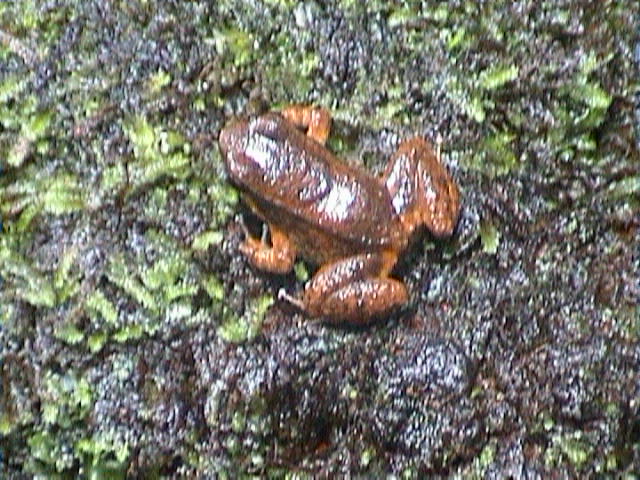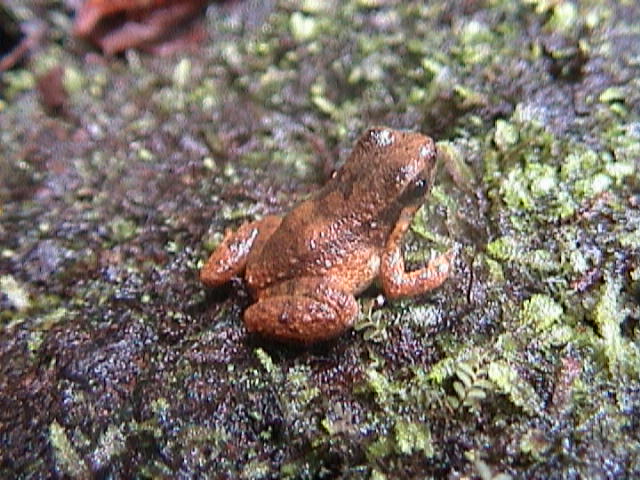Anomaloglossus degranvillei: The Hidden Jewel of Amazonian Frogs#
Deep within the lush embrace of the Amazon rainforest, beneath a shaded canopy illuminated only by brief glimpses of sunlight, lives a delicate and secretive inhabitant: Anomaloglossus degranvillei. As cryptic as it is captivating, this tiny amphibian embodies the intricate dance between evolution, adaptation, and environmental intimacy that defines wildlife in pristine ecosystems. Known neither for flamboyant colorations nor conspicuous behaviors, it is precisely the subtle charm and ecological significance of this elusive creature that makes it an enthralling subject of study and conservation.
Given the subtlety of its appearance and behavior, Anomaloglossus degranvillei is not the subject of common conversation among wildlife enthusiasts. Yet, beneath its modest visage lies a rich tapestry of ecological adaptations, behavioral intrigues, and cultural importance stretching back generations. Journey into the rainforest and discover the secrets behind this fascinating amphibian, a tiny guardian of environmental stability that offers immense insights into the health of the Amazonian habitats it inhabits.
Taxonomy and Classification#
The scientific journey to understand this species begins with taxonomy, providing a framework for exploring both its uniqueness and its kinship with other creatures. Anomaloglossus degranvillei belongs to the class Amphibia, order Anura, family Aromobatidae—a group distinguished by their small, cryptic appearance and complex ecological roles. Within Aromobatidae, the genus Anomaloglossus includes several closely related frogs known for terrestrial habits and intriguing reproductive strategies.
This species was formally described by Lescure in 1975, etching its name officially into scientific literature. It was named in honor of Jean-Jacques de Granville, a renowned botanist whose extensive exploration in French Guiana significantly contributed to the understanding of Amazonian biodiversity. Close relatives sharing similar ecological niches and behavior patterns include other members of the genus Anomaloglossus, making studying this frog essential in understanding Amazonian amphibian evolution and diversity.
Natural Habitat#
Anomaloglossus degranvillei inhabits the lush tropical forests of French Guiana, specifically areas deeply embedded in pristine Amazonian rainforest ecosystems. Very specialized, this frog requires untouched moist forests with a dense leaf-litter layer covering damp, nutrient-rich soils that are occasionally punctuated by shallow, slowly-flowing forest streams.
The Subtle Realm of Leaf Litter#
The frog’s preferred habitat is within the microcosm created by fallen leaves and organic debris. Here, amidst shadows and the perpetual dampness, the frogs scurry quietly between leafy shelters, retreating swiftly at the slightest disturbance. It’s no casual choice; thick leaf-litter offers both protection from predators and abundant food resources—primarily small insects, spiders, and mites thriving beneath the decaying foliage.
Engaging all senses, the forest floor becomes a fragrant carpet of decay, earthy scents mingling with the subtle fragrance of moisture-rich plants. The subdued soundscape echoes with faint rustlings of diminutive creatures moving invisibly under the debris—a hidden world thriving just inches away from casual observation.
Physical Characteristics#
Though diminutive in stature, rarely surpassing 2 centimeters in length, Anomaloglossus degranvillei effortlessly captures attention with its intricate form and subdued beauty. Their slender bodies boast hues ranging from light brown to shades of muted olive and tan—a delicate tapestry perfectly attuned to blend seamlessly with the leaf litter they call home. Brownish mottling adorns their backs, resembling fallen foliage patterns, providing unrivaled camouflage that aids survival in a highly competitive ecosystem fraught with predation pressures.
One curious physical adaptation is their textured skin, subtly granular yet moist, a physiological trait critical for effective water balance in the humid microclimate of dense leaf litter habitats. With large eyes and acute senses finely attuned to movement, these frogs excel at detecting both prey and predator, transforming their limited visibility environment into a realm mastered by subtle sensory perception.
Behavior and Life Cycle#
Despite their elusive nature, these frogs exhibit fascinating behaviors that captivate researchers and nature enthusiasts alike. As primarily diurnal creatures, they spend daylight hours attentively exploring leaf litter in search of minuscule insects—ants, spiders, and mites—captured with lightning-fast tongue strikes or meticulously pursued under cover of debris.
Mating Calls: Quiet Voices on the Forest Floor#
During the breeding season, typically correlated with wet periods when humidity is highest, the forest comes alive with subtle, melodious calls emanating from hidden males hoping to attract receptive females. Their ethereal calls—a series of soft, rasping clicks and buzzes—permeate the leaf litter layer, guiding potential mates closer amidst the competitive chorus.
Caretakers of the Next Generation#
A particularly compelling aspect of their reproduction is dedicated parental care. After careful site selection, females deposit small clutches of eggs into hidden leaf litter recesses, where moisture conditions remain ideal. Then comes vigilant guard duty; one parent, usually the male, diligently oversees the clutch, protecting developing embryos from fungal infections, predators, and dehydration until eggs hatch into tiny tadpoles.
Subsequently, tadpoles find their way to nearby shallow streams and damp depressions, completing their aquatic life cycle stages. Metamorphosis occurs swiftly, with juveniles emerging miniature but fully prepared for terrestrial life—a testament to evolutionary resilience and ecological adaptability.
Ecological Role#
Far more consequential than their small stature may initially suggest, Anomaloglossus degranvillei plays pivotal roles in its ecosystem. Acting both as predator and prey, the frogs regulate populations of insects and other arthropods, maintaining delicate ecological balances that cascade upward through the food web.
The species also serves as a crucial indicator organism, reflecting the overall health and integrity of pristine rainforest habitats. Any disturbances or imbalances within their microhabitats, notably pollutants or sudden climate shifts, swiftly manifest in declining populations, signaling environmental stresses that may later impact myriad other species. Thus, their ongoing presence is synonymous with habitat health, an assurance of intact ecological processes beneath the rainforest canopy.
Threats and Conservation Status#
Despite its remote habitat, the pressures exerted by contemporary threats such as logging, mining, climate change, and pollution gradually encroach upon the fragile world of Anomaloglossus degranvillei. Habitat fragmentation remains a prevailing issue in French Guiana, causing disruptions to breeding sites, reducing genetic diversity, and increasing vulnerability to diseases and natural predation.
While currently not enough data exist to classify the precise conservation status of this shy frog thoroughly, researchers stress early awareness. As an indicator species, maintaining healthy populations of Anomaloglossus degranvillei vividly underscores the continued preservation of intact forest habitats. Prominent conservation organizations work tirelessly to study amphibian diversity and habitat stability, calling for protective legislation and sustainable land-use practices to safeguard not only this species but the incredible biodiversity of Amazonia itself.
Cultural and Scientific Significance#
While not prominently featured in folklore or mythology, frogs such as Anomaloglossus degranvillei occupy unique positions within indigenous traditional understanding, often symbolizing renewal, health, and environmental harmony. Scientifically, their sensitivity to environmental changes renders them essential organisms for climate-change studies, targeted pollution mitigation efforts, and the broader understanding of Amazonian forest dynamics.
Conclusion#
Anomaloglossus degranvillei stands as a quiet ambassador for one of Earth’s richest ecosystems. Though modest in appearance and secluded in behaviors, its significance resonates profoundly—offering insights into complex rainforest relationships, environmental stability, and conservation priorities. Protecting this gentle amphibian serves as a powerful reminder of humanity’s interconnectedness with nature, urging us toward responsible choices to preserve and celebrate this hidden jewel and the irreplaceable habitats that sustain it.
Let us take inspiration from this small yet mighty creature—engaging with conservation science, supporting protective initiatives, and advocating passionately for the invaluable gift that is biodiversity. For beyond its small frame thrives a universe of discovery, harmoniously echoing lessons vital for our planet’s future.


















